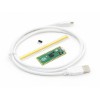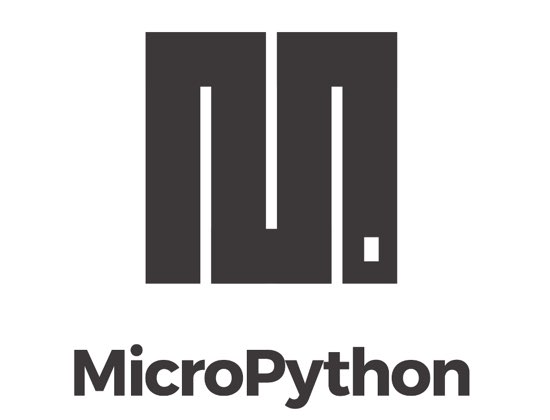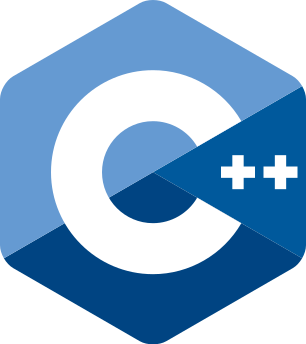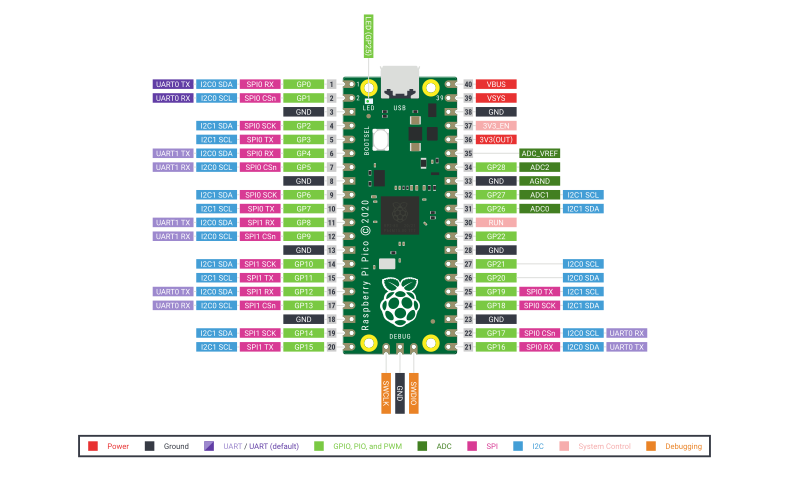- -€0.96





€5.08 tax excl.
Starter kit containing Raspberry Pi Pico, necessary connectors and a microUSB cable. The kit is recommended for people programming in MicroPython

free shipping in Poland for all orders over 500 PLN

If your payment will be credited to our account by 11:00

Each consumer can return the purchased goods within 14 days
The Raspberry Pi Pico is the first board to feature a microcontroller designed by the Raspberry Pi foundation. The chip that is the heart of this board has been equipped with two ARM Cortex M0+ cores operating at a frequency of 133 MHz, 256 KB of RAM and 30 GPIO ports. The microcontroller itself is not equipped with flash memory, but on the board there is an external memory with a capacity of 2 MB connected via the QSPI interface. The platform supports the popular MicroPython and C/C++ programming languages. Programs can be uploaded to memory via the USB interface in mass storage mode or by using an external programmer that supports the SWD interface.

Kamami is the official distributor of Raspberry Pi minicomputers and dedicated accessories.

MicroPython is a special version of the Python 3 programming language, prepared to run directly on embedded systems such as the Raspberry Pi Pico. The version prepared especially for the RP2040 microcontroller, supports REPL, an interactive shell that allows you to execute scripts, typing into the console and viewing the results of the program in it. Thanks to this technology, it is also possible to save the program in flash memory.
To facilitate the programming of the RP2040 microcontroller in C / C ++, the Raspberry Pi Foundation has prepared an official SDK toolkit that can be integrated with popular IDEs such as Visual Studio Code or Eclipse. The entire environment configuration process is described in the Getting started with Raspberry Pi Pico document.


The Raspberry Pi Pico can be programmed via the USB interface, it can be done in two ways.
The first is the USB mass storage mode, to program the board in this way, press and hold the BOOTSEL button, and then connect the board to the computer with a USB cable. The device will be recognized as mass memory to which you can upload the program in the same way as copying files to a pendrive. After uploading the program, the microcontroller will automatically reset and start the uploaded program. This method is suitable for uploading programs written in C / C ++ or for uploading the MicroPython interpreter.
The second way works only with programs written in MicroPython and requires prior loading of the interpreter using the first method. This method consists in saving the program layout transferred with REPL in the memory.
When programming in C/C++, there is often a need to repeatedly test the program. Loading a program via USB requires repeating the procedure every time, disconnecting the board from the computer, pressing the button and connecting the board, and then finding the compiled program and copying it to memory. The whole thing takes quite a long time, but fortunately it can be simplified using an external programmer with SWD interface. Programming via SWD is much faster, you only need to connect the programmer once with a 3-pin connector and power supply e.g. via USB and you can upload programs directly from the IDE. In addition, you can debug the program in this way and efficiently find any errors in the code by running it line by line.
The Raspberry Pi Pico is designed to be programmed directly with the Raspberry Pi 4B or 400. The manufacturer has prepared detailed instructions for setting up programming environments and ready-made configuration scripts. Pico can be programmed from the Raspberry minicomputer both via USB and via SWD. The big advantage of this solution is no need to use an external SWD programmer. Pico ports can be connected to RPI ports. To ensure a stable connection, you should connect Pico directly to the minicomputer, the use of the contact plate may introduce interference.
To use the full potential of programming environments, it is recommended to use minicomputers with min. 4 GB of RAM.
The Raspberry Pi Foundation has prepared the Picoprobe application that allows you to change RPI Pico into an SWD programmer and a USB - UART converter. Thanks to this, you can program the RP2040 without the need for an SWD programmer, using only the second board with the RP2040 microcontroller.
Warning!
The Raspberry Pi Pico board does not include goldpin connectors and a microUSB cable. Our offer includes connectors for GPIO 1x40 (they can be easily divided into two 1x20 connectors) and a connector 1x3 for a programmer. There are also ready-made kits containing connectors, a microUSB cable and / or a programmer / minicomputer RPI 4B.

Module with RP2040 microcontroller dedicated to matrix displays with HUB75 interface. Pimoroni PIM584
Board with the RP2040 microcontroller in the form of a USB dongle. Equipped with edge connectors, RGB LED, boot and reset button. Waveshare RP2040-One
Mini board with RP2040 microcontroller equipped with two ARM Cortex-M0 + 133 MHz cores, 264 kB RAM. The board also has 8 MB of QSPI flash memory. The circuit can be programmed in C/C++, CircuitPython or MicroPython. Pimoroni SP011
No product available!
Versatile digital video module. It uses two RP2040 chips (one in the form of a Raspberry Pi Pico W board and the other as a separate RP2040 microcontroller) and is equipped with an HDMI output connector. Pimoroni PIM686
No product available!
Development board based on the RP2040 microcontroller. It is equipped with a 1.14" color LCD display and a built-in debugging tool via USB interface. The board is enclosed in a plastic housing. Waveshare RP2040-GEEK
The board with the RP2040 microcontroller equipped with two ARM Cortex-M0 + cores operating at a frequency of 133 MHz, 264 kB RAM. The board also has 2 MB of QSPI flash memory. In addition, the board is equipped with the Infineon CYW43439 system, extending the board with wireless connectivity. Raspberry Pi SC0918
The board with the RP2040 microcontroller equipped with two ARM Cortex-M0+ cores, which work at a frequency of 133 MHz, 264 kB RAM. The board also has 2 MB of QSPI flash memory. The system can be programmed in C/C++ or MicroPython. Waveshare RP2040-LCD-0.96-M
Module with a 2.9" ePaper display and a Raspberry Pi Pico W board equipped with WiFi communication. It has a built-in Qwiic/Stemma QT connector with an I2C interface, buttons and a battery connector. Perfect as a display for a weather station. Pimoroni PIM669
No product available!
The RP2040 microcontroller board features two ARM Cortex-M0+ cores that operate at 133 MHz. It has 264 kB of RAM, and the board also includes 16 MB of QSPI Flash memory. The chip can be programmed in C/C++ or MicroPython. Waveshare RP2040-Plus-16MB
No product available!
Mini board with the RP2040 microcontroller equipped with two ARM Cortex-M0 + cores, which work at a frequency of 133 MHz and 264 kB RAM. The board also has 8 MB of QSPI flash memory. The system can be programmed in C/C++ or MicroPython. Pimoroni PIM558
NeoPixel 8-channel RGB LED driver. It features an RP2040 microcontroller with two ARM Cortex-M0+ cores, 264 kB of RAM and 8 MB of external Flash memory. Adafruit 5650
Development board with RP2040 microcontroller. Equipped with a microBUS connector, it can work with Qwiic expansion boards. SprakFun DEV-18721
The first microcontroller designed by the Raspberry Pi foundation, equipped with two ARM Cortex M0 + cores clocked at 133 MHz, 264 KB of RAM and 30 ports with I2C, SPI, UART and USB interfaces. External flash memory can be connected via the QSPI interface. The system can be programmed in C / C ++ or microPython. Raspberry Pi SC0908
Development board with RP2040 and ESP-12E microcontroller. Equipped with 0.91" OLED display. SB Components 24186
A kit containing an LED strip driver module and WS2812/Neopixel tape. Designed to easily and quickly create animations using popular RGB LED strips. Pimoroni PIM657
No product available!
LED strip driver module dedicated to the WS2812, Neopixel and SK6812. Designed to easily and quickly create animations using popular RGB LED strips. Pimoroni PIM653

Starter kit containing Raspberry Pi Pico, necessary connectors and a microUSB cable. The kit is recommended for people programming in MicroPython
